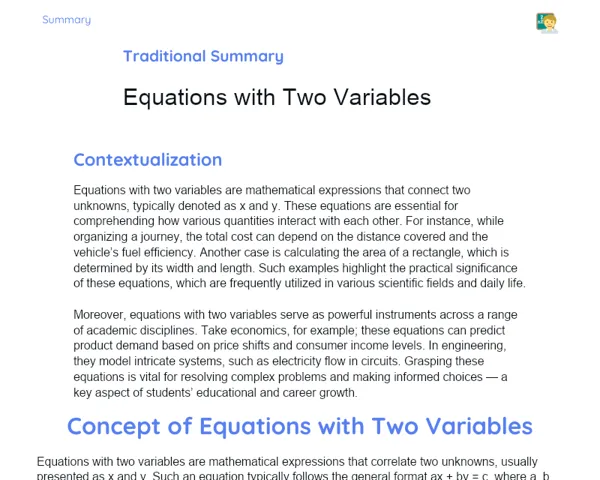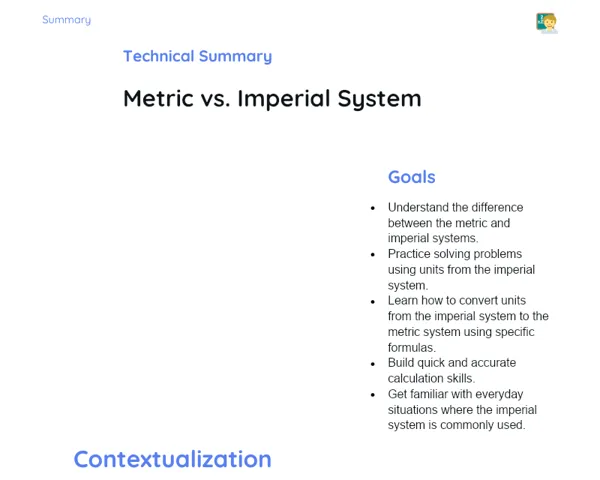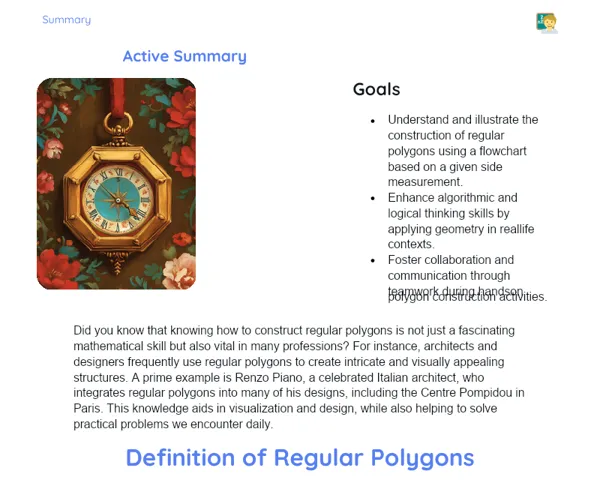Summary Tradisional | Volume: Relationships with Cubes
Contextualization
The concept of volume is crucial in mathematics and various fields of study. Volume refers to the amount of space an object occupies and is measured in cubic units, such as cubic centimeters (cm³) or cubic meters (m³). Understanding how to calculate volume enhances our comprehension of three-dimensional space, be it a cardboard box, a water tank, or even in building designs. Grasping how to measure volumes is a vital skill that aids problem-solving in everyday life and in different careers.
In this lesson, we will use unit cubes to learn how to calculate the volume of simple spatial figures. A unit cube is defined as a cube with each edge measuring one unit. By stacking these cubes, we can create various geometrical shapes and compute the total volume they occupy. This hands-on method helps us visualize and solidify the concept of volume, making learning more concrete and relatable. Furthermore, we will explore real-life scenarios where this knowledge can be applied, such as in construction and handling liquid containers.
To Remember!
Concept of Volume
Volume refers to the amount of space taken up by an object in a three-dimensional context. This concept is fundamental across multiple disciplines, from mathematics to physics and engineering. To fully grasp volume, it's essential to visualize objects in three dimensions, taking into account their width, height, and depth.
In mathematics, volume is typically measured in cubic units like cubic centimeters (cm³) and cubic meters (m³). These units represent cubes where each edge has a specific length. For instance, a cube with edges of 1 cm has a volume of 1 cm³. Understanding these units is crucial for accurately measuring and calculating the volumes of various objects.
The idea of volume also finds applications in our daily lives, such as determining how much a box can hold or the capacity of a water tank. Being adept at calculating volume is beneficial for figuring out the capacity of containers and optimizing space usage. This skill is invaluable in many professions, including architecture and engineering.
-
Volume is the amount of space occupied by an object.
-
Measured in cubic units, such as cm³ and m³.
-
Relevance in daily life and professional fields, including containers and construction.
Units of Volume Measurement
Units for measuring volume are key to quantifying how much three-dimensional space an object occupies. The most commonly used units are cubic centimeters (cm³) and cubic meters (m³). These units stem from the lengths of the edges of the cubic shapes they represent. For example, a cube with 1 cm edges has a volume of 1 cm³, while a cube with 1 m edges has a volume of 1 m³.
Besides cubic centimeters and cubic meters, there are other volume units like liters (L) and milliliters (mL), mainly used for liquids. One liter corresponds to 1,000 cm³, whereas one milliliter equals 1 cm³. These units are handy in everyday scenarios for measuring liquid quantities.
Being familiar with the various units of volume measurement and understanding how to convert them is vital for tackling practical challenges. For example, when figuring out the volume of a box in cubic centimeters, you might need to convert this measurement to liters if the box contains liquid.
-
Common units of measurement: cm³ and m³.
-
Other units: liter (L) and milliliter (mL).
-
Conversion between units is crucial for practical applications.
Stacking Cubes
Stacking unit cubes is a tangible way to grasp the concept of volume. A unit cube is simply a cube where each edge measures one unit, like 1 cm or 1 m. By stacking these cubes, we can create various geometric shapes and calculate the total volume they encompass. For instance, lining up 3 unit cubes results in a total length of 3 units.
To create larger forms, we can arrange the cubes in different dimensions. For example, by stacking cubes in three rows with three units each and two layers high, we obtain a rectangular prism with a volume of 3 x 3 x 2 = 18 cubic units. This visual and practical method helps consolidate the understanding of volume, making it more relatable and easier to grasp.
Apart from aiding in the understanding of volume, stacking unit cubes provides the opportunity to explore diverse spatial forms and their volumetric relationships, which is especially beneficial for students who learn better through visual and hands-on methods.
-
Unit cube: each edge measures one unit.
-
Stacking cubes leads to different geometric formations.
-
A visual and practical way to comprehend volume.
Volume Calculation
Calculating the volume of spatial figures is a vital skill in mathematics. The basic formula for finding the volume of a cube or rectangular prism is to multiply the length, width, and height (Volume = Length x Width x Height). For example, for a box measuring 3 units in length, 2 units in width, and 4 units in height, the volume calculates as 3 x 2 x 4 = 24 cubic units.
Practicing volume calculations with different spatial figures is important for mastering this skill. Working through problems on the board with practical examples fosters understanding of how to apply the formula in real situations. Additionally, visualizing three-dimensional models can ease the comprehension of the calculation process.
Volume calculation is not confined to cubes and rectangular prisms. Other geometric shapes, such as cylinders and spheres, have their specific formulas for volume calculation. Being familiar with these formulas and knowing how to use them is key to tackling more complex and varied problems.
-
Basic formula: Length x Width x Height.
-
Practicing with various spatial figures is crucial.
-
Specific formulas exist for more complex geometric shapes.
Key Terms
-
Volume: Amount of space occupied by an object.
-
Unit Cube: A cube where each edge measures one unit.
-
Cubic Units: Measurement of volume, such as cm³ and m³.
-
Stacking Cubes: A method for building larger figures and understanding volume.
-
Length, Width, Height: Dimensions essential for volume calculation.
-
Rectangular Prism: A three-dimensional geometric shape formed by six rectangular faces.
Important Conclusions
In this lesson, we delved into the concept of volume, which represents the space occupied by an object. We used unit cubes to visualize and calculate the volume of simple spatial figures, including cubes and rectangular prisms. We learned that volume is measured in cubic units, like cubic centimeters (cm³) and cubic meters (m³). Stacking these cubes enhances our understanding of three-dimensional space.
We covered the basic formula for volume calculation: Volume = Length x Width x Height. This formula helps us determine the volume of various objects and is particularly useful in real-life situations, such as checking the capacity of boxes and containers. By solving practical problems, we reinforced our comprehension and demonstrated how to apply this knowledge in real-world contexts.
Grasping the concept of volume and knowing how to compute it is a crucial skill with applications across fields like construction, engineering, and even in day-to-day activities. We encourage everyone to keep exploring this topic, as mastering this skill makes problem-solving easier and facilitates the execution of practical tasks in everyday life.
Study Tips
-
Practice calculating the volume of different items at home, such as boxes and containers, using the formula discussed in class.
-
Use visual and tactile resources, such as building blocks, to effectively visualize and solidify your understanding of volume.
-
Work through additional problems from math textbooks or seek out exercises online to reinforce and deepen your knowledge of volume calculation.



